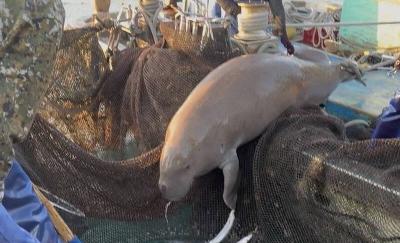Academia Sinica geoscience researchers yesterday unveiled a study that used GPS data to track the nation’s crustal changes following the 921 Earthquake in 1999, to shed more light on the creation of mountains and seismic cycles.
The magnitude 7.3 earthquake occurred on Sept. 21, 1999, in Nantou County’s Jiji Township (集集), leaving 2,456 people dead and destroying thousands of buildings.
Subterranean rocks at a depth of 20km had stabilized one year after the quake, but deeper layers might be still changing very slowly today, Academia Sinica Institute of Earth Sciences researcher Hsu Ya-ju (許雅儒) said.

Photo: Chien Hui-ju, Taipei Times
While GPS data has been used to study fault lines in previous studies, the team developed a new method of using such data to model geographical changes from the Earth’s surface to subterranean layers 50km in depth without having to make a lot of hypotheses, she said.
The study extends from a master’s thesis written by Tang Chi-hsien (唐啟賢) in 2016, when he was studying at National Central University, Hsu said.
Tang, 27, is serving alternative military service by doing research at the institute and plans to return to National Taiwan University to complete his doctoral degree.
Hsu and Tang worked with University of Southern California professor Sylvain Barbot and Nanyang Technological University professor James Moore to study GPS data about crustal changes collected over 14 years following the quake.
Taiwan has many mountains higher than 3,000m, but it is not yet clear how they arose from the Earth’s crust and the team’s study could offer some clues, Tang said.
Tang grew up in Hualien, where earthquakes are frequent, and that motivated him to research seismic activity, he said.
The team detailed their findings in a paper titled “Lower-crustal rheology and thermal gradient in the Taiwan orogenic belt illuminated by the 1999 Chi-Chi earthquake” which was published in the journal Science Advances.
The team’s findings are also useful for other nations, as rock strata in different nations share common features, institute director Chung Sun-lin (鍾孫霖) said.
To commemorate the 20th anniversary of the 921 Earthquake, the Taiwan Earthquake Research Center is to hold an international conference in September, Chung added.

‘DENIAL DEFENSE’: The US would increase its military presence with uncrewed ships, and submarines, while boosting defense in the Indo-Pacific, a Pete Hegseth memo said The US is reorienting its military strategy to focus primarily on deterring a potential Chinese invasion of Taiwan, a memo signed by US Secretary of Defense Pete Hegseth showed. The memo also called on Taiwan to increase its defense spending. The document, known as the “Interim National Defense Strategic Guidance,” was distributed this month and detailed the national defense plans of US President Donald Trump’s administration, an article in the Washington Post said on Saturday. It outlines how the US can prepare for a potential war with China and defend itself from threats in the “near abroad,” including Greenland and the Panama

A wild live dugong was found in Taiwan for the first time in 88 years, after it was accidentally caught by a fisher’s net on Tuesday in Yilan County’s Fenniaolin (粉鳥林). This is the first sighting of the species in Taiwan since 1937, having already been considered “extinct” in the country and considered as “vulnerable” by the International Union for Conservation of Nature. A fisher surnamed Chen (陳) went to Fenniaolin to collect the fish in his netting, but instead caught a 3m long, 500kg dugong. The fisher released the animal back into the wild, not realizing it was an endangered species at

The Chinese Nationalist Party (KMT) is maintaining close ties with Beijing, the Democratic Progressive Party (DPP) said yesterday, hours after a new round of Chinese military drills in the Taiwan Strait began. Political parties in a democracy have a responsibility to be loyal to the nation and defend its sovereignty, DPP spokesman Justin Wu (吳崢) told a news conference in Taipei. His comments came hours after Beijing announced via Chinese state media that the Chinese People’s Liberation Army’s Eastern Theater Command was holding large-scale drills simulating a multi-pronged attack on Taiwan. Contrary to the KMT’s claims that it is staunchly anti-communist, KMT Deputy

The High Prosecutors’ Office yesterday withdrew an appeal against the acquittal of a former bank manager 22 years after his death, marking Taiwan’s first instance of prosecutors rendering posthumous justice to a wrongfully convicted defendant. Chu Ching-en (諸慶恩) — formerly a manager at the Taipei branch of BNP Paribas — was in 1999 accused by Weng Mao-chung (翁茂鍾), then-president of Chia Her Industrial Co, of forging a request for a fixed deposit of US$10 million by I-Hwa Industrial Co, a subsidiary of Chia Her, which was used as collateral. Chu was ruled not guilty in the first trial, but was found guilty